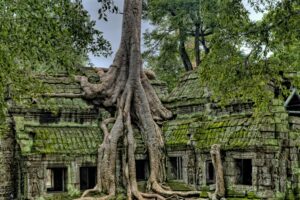
Preserving Toledo’s Historic Woodlands
A new initiative aims to restore the area’s historic tree cover. That’s good news for the environment, as well as for the community.
Ancient woodland tends to be managed by a regime of felling and regrowth, known as coppicing. This exploits the natural property of many trees to regenerate from stump sprouts and root suckers – an ability that has evolved over time.
1. Sycamore
As part of the riverfront woodlands in their native habitat, sycamores create an arch of branches that provide cover and shelter. Their large girth and thick, smooth bark make them easy to identify in winter, and their wide canopies can help you locate a stream or river bank from a distance.
Sycamores are very tolerant of poor soils, and often thrive in the poorly drained mucky or peaty bottoms of streams. In these environments, sycamores are often the tallest trees in their area and form a broad canopy of leaves and branches.
In spring, sycamores are covered in a dense mass of flowers including bluebells and other wildflowers (like primrose, ox-eye daisies, and lemon slug). These wildflowers indicate the presence of ancient woodland and function as indicator species that a site is worth conserving.
Sycamores are famous for their connection to American history, as evidenced by the sycamore that sheltered General George Washington and Lafayette at the Battle of Brandywine in 1777. Historically, pioneers used hollowed-out trunks to store grain and smoke meat, and many historical sycamores were sawn into wide wooden panels for Pullman passenger cars.For more information about these majestic trees and their significance in riverfront ecosystems, visit our website.
2. Maple
Often used as shade trees, the maple (Acer) family offers a wide variety of shapes and foliage colors. Many species produce valuable syrup. Maples also make attractive hedging.
As glaciers receded from Europe, woodlands grew to cover large areas, with dominant trees differing by region: in southern England lime was more common than elsewhere; hazel supplied hedge stakes and thatching spars; ash served as tool handles; and oak was preferred for barrels, hay rakes, construction, and wheels (and its bark was stripped for tanning). Within woodlands the trees were cut every ten or twenty-five years in a pattern known as coppice with standards.
Such ancient woodland habitat is still in existence—but rare, with less than 1.5 percent of the country’s woodland categorized as such. The oldest woodlands have survived centuries of clearance and regrowth. They offer a wild, largely undisturbed environment for wildlife, from roe deer and badgers to the lemon slug (Malacolimax tenellus).
3. Elm
The elms of the Ulmus genus are relatively fast growing trees, gaining up to three feet per year in ideal conditions. They grow to a height of about 75 feet and develop an umbrella-like form. Their dark green foliage and serrated leaves turn outstanding shades of yellow and gold in fall.
They can be planted closer to sidewalks and patios than other large shade trees because their roots do not damage paving as extensively. Elms are also tolerant of sprinkler irrigation.
As a result, they are popular as street trees in urban settings. They are also a common choice for park plantings because they are drought and pollution resistant and tolerate severe pruning. They are a favored ornamental tree and were featured in the landscapes of famous artists including John Constable and Ferdinand Georg Waldmuller. They are an important indicator of ancient woodland, providing a home for woodland plants and animals. But the vast majority of historic woodland sites in Britain have been cleared and replaced by tree plantations, often of nonnative species.
4. Oak
A woodland ecosystem is more than just a forest. It includes different habitats and features, from flora to fauna to anthropology. It is a dynamic place of change and yet one that can also foster long-term stability.
Wood products generated income and helped sustain small-scale industries that manufactured farming tools, barrels, wagon wheels and construction materials. Oak trees were preferred for wheel spokes and for the leather-tanning industry, which demanded its bark. These demands led to a pattern of cutting, where the outer edge of a grove would be cut every ten or twenty-five years, with the inner area left to regrow.
Today, you can visit these special places at Toledo Metroparks. For example, visitors to the Wildwood Preserve can see ancient woodland landscapes where a variety of wildlife thrives, from roe deer to badgers. Despite the noise of a chainsaw, which is a modern version of an axe or crosscut saw, it is a sound that reminds us of a time when we were more connected to our natural world.